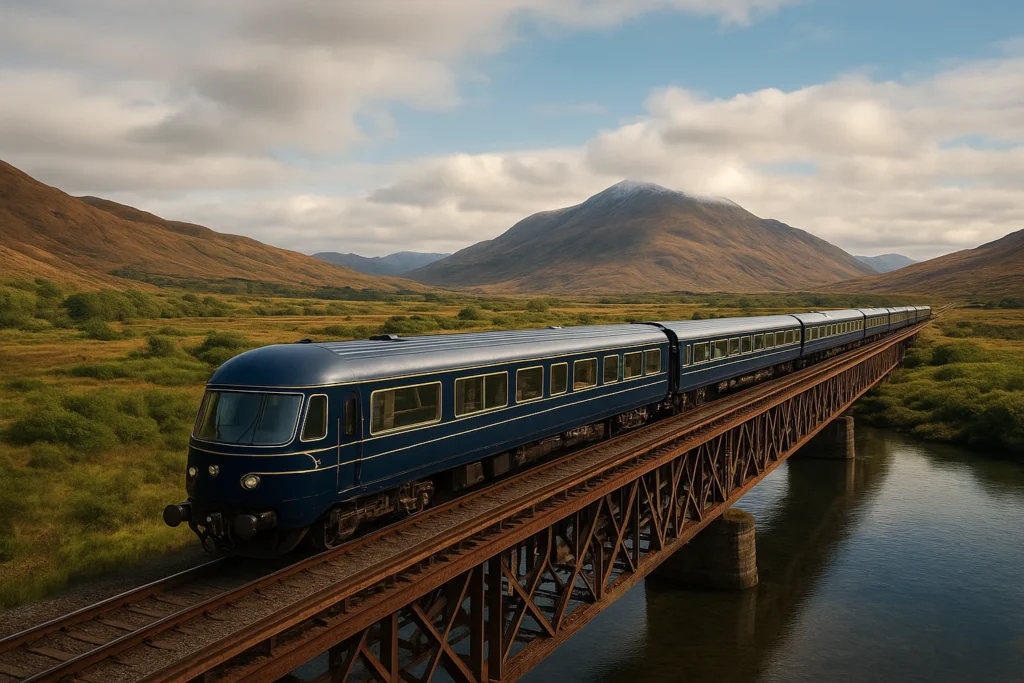Prologue: The Dawn of a New Era in Travel
The first light of dawn had not yet touched the Atlantic waters when the platform at Lagos station began to fill with a sense of palpable anticipation. Under the soft glow of vintage-style lanterns, a curious assembly of journalists, railway historians, and fortunate passengers gathered, their breath forming small clouds in the cool morning air. They had come from across the globe to witness what many had deemed impossible: the maiden voyage of the first continuous passenger train from Europe’s western edge to Southeast Asia’s vibrant heart.
At precisely 6:07 AM, a deep, resonant whistle echoed through the coastal fog—a sound that would become the defining rhythm of the next three weeks. Emerging from the mist came not merely a train, but a moving masterpiece of polished steel and glass, its dark blue carriages accented with gold leaf that shimmered under the station lights. This was the Eurasian Majesty, and its departure marked the beginning of the most ambitious passenger rail journey ever conceived: an 18,755-kilometer odyssey across thirteen countries, through eight time zones, and over twenty-one days of unparalleled luxury and discovery.
For the select few aboard, this was more than transportation; it was a transformative experience that would redefine their understanding of distance, culture, and connection. As the final boarding calls echoed in multiple languages, the train began its slow, graceful movement eastward, leaving the Atlantic shores behind and embarking on a journey that would stitch together continents, cultures, and centuries of railway history.
Chapter I: The Genesis of a Transcontinental Dream
The concept of linking Europe to Asia by rail is a vision that has captivated explorers and engineers since the golden age of steam. In the late 19th century, as the Trans-Siberian Railway began taking shape across Russia’s vast expanse, visionaries already dreamed of extending these steel threads further east, creating a continuous land bridge between continents. For over a century, this remained precisely that—a dream, hampered by impossible geography, political divisions, and technological limitations.
The modern incarnation of this vision began taking shape in boardrooms and engineering firms across Europe and Asia in the early 2000s. The catalyst came not from railway enthusiasts but from geopoliticians and economists who recognized the strategic importance of creating robust land connections between Europe and Asia. What began as a series of disconnected national projects gradually coalesced into a coordinated international effort, with the China-led Belt and Road Initiative providing crucial momentum and funding.
The final breakthrough came with two critical developments: the completion of the Laos-China Railway in December 2021, which conquered the notoriously difficult terrain of northern Laos with 75 tunnels and 167 bridges, and the standardization of customs and immigration procedures across thirteen nations. This latter achievement represented a diplomatic marvel nearly as impressive as the engineering feats—a complex web of bilateral agreements that allowed for pre-clearance and onboard processing while the train continued moving.
The naming of the service—Eurasian Majesty—was chosen after an international competition that received over 50,000 submissions. The winning entry came from a retired history teacher in Vienna who wrote: “This train will carry not just passengers, but the majesty of human cooperation across the most diverse landscape on Earth.”
Chapter II: The European Prelude – From Atlantic Shores to Continental Crossroads
The Iberian Beginning: Portugal and Spain
The first days of the journey unfold as a gradual awakening to the art of slow travel. Leaving the Atlantic behind, the train climbs through Portugal’s interior, where ancient cork oak forests and whitewashed villages cling to hillsides that have changed little in centuries. The first evening aboard is marked by a welcome gala featuring Portugal’s finest wines and fado music that seems to echo the melancholy beauty of the landscape.
As the train crosses into Spain, the scenery transforms into the vast, sun-baked plains of Extremadura, where black Iberian pigs graze beneath oak trees and medieval fortress towns crown distant hills. Here, the train makes its first extended stop in Madrid, allowing passengers to experience the vibrant energy of a European capital before continuing eastward.
The French Passage: From Basque Country to Vineyards
The crossing into France brings another dramatic shift in landscape and culture. The train navigates the graceful curves of the Pyrenees, offering breathtaking views of snow-capped peaks and remote valleys where time seems to have stood still. In the dining car, the menu transitions to French cuisine—rich coq au vin, delicate terrines, and cheeses that tell the story of each region passed through.
A scheduled stop in Bordeaux allows passengers to visit legendary vineyards and understand how terrain and climate create the world’s most celebrated wines. Back aboard, sommeliers conduct tastings that pair vintages with the passing scenery, creating a multisensory experience that becomes a hallmark of the journey.
Central European Transition: Germany and Beyond
The character of the journey evolves yet again as the train enters Central Europe. The landscapes become more orderly, with neat farmlands and forests that have been carefully managed for generations. In Germany, the train makes a technical stop in Munich, where engineers conduct the first of several thorough inspections while passengers explore the city’s historic center.
As the journey continues into Poland and Belarus, the architecture outside the windows tells a story of complex history and resilience. Onboard lecturers provide context about the regions being traversed, helping passengers understand the layers of history visible in the landscape—from medieval castles to Soviet-era infrastructure and modern European development.
Chapter III: The Russian Epic – Across the World’s Largest Nation
Entering the Bear: Border Crossings and First Impressions
The crossing into Russia represents the journey’s first major geographical and psychological threshold. At the border station, passengers witness the fascinating bogie-changing ceremony—a precisely choreographed operation where specialized machinery lifts each carriage and swaps its wheel sets to accommodate Russia’s broader rail gauge. This process, which takes several hours, becomes a memorable spectacle, with engineers working with the precision of surgeons beneath the curious gaze of passengers.
Once across the border, the scale of everything changes dramatically. The train begins its long traverse across the West Siberian Plain, where forests and wetlands stretch to horizons that seem infinitely distant. The sense of entering a land of mythic proportions settles over the passengers, enhanced by onboard experts who share stories of Russian history, literature, and exploration.
The Taiga: Days in the Green Cathedral
For nearly five days, the train journeys through the taiga—the world’s largest forest ecosystem that contains more trees than there are stars in the Milky Way. This segment of the journey takes on a meditative quality, with the endless procession of birch and pine trees creating a green tunnel that occasionally opens to reveal pristine rivers and remote settlements.
The train makes a scheduled stop at Lake Baikal, the deepest and oldest freshwater lake on Earth. Here, passengers spend a full day exploring the shoreline, learning about the unique ecosystem, and even taking a dip in the crystal-clear waters (for the brave-hearted, as even in summer the water remains breathtakingly cold). Local Buryat communities welcome visitors with traditional performances and meals featuring omul fish, found only in Baikal’s waters.
Cultural Immersion: Russian Traditions Onboard
As the landscape unfolds outside, the onboard experience deepens its Russian character. The dining cars transition to serve borscht, pelmeni, blini, and other Slavic specialties prepared by chefs who have joined the train for this segment. Language classes introduce passengers to Cyrillic and useful phrases, while evenings feature Russian cinema, classical music performances, and lectures on everything from the Romanov dynasty to the space race.
The train’s spa car introduces treatments inspired by Russian traditions—venik massage using birch branches, honey wraps, and revitalizing treatments using ingredients sourced from the Siberian forest. For many passengers, this extended immersion in Russian culture becomes one of the journey’s most memorable aspects, fundamentally altering their understanding of the world’s largest nation.
Chapter IV: The Asian Transformation – From Mongolian Steppes to Chinese Megalopolises
The Mongolian Passage: Where Sky Becomes Land
The transition from Russia to Mongolia is both gradual and dramatic. The dense forests of Siberia slowly give way to more open country, then suddenly explode into the breathtaking expanse of the Mongolian steppe. Here, the horizon seems to stretch forever under a dome of blue that feels somehow larger than elsewhere on Earth.
The train schedules two days across Mongolia at a deliberately leisurely pace, allowing passengers to fully absorb the profound emptiness and beauty of this unique landscape. Wild horses often run parallel to the train, their manes flowing in the wind as if welcoming this strange metal visitor to their ancient homeland.
A scheduled stop at a traditional ger camp allows passengers to experience nomadic hospitality firsthand. They learn about eagle hunting, participate in archery demonstrations, and taste airag (fermented mare’s milk) around campfires under some of the clearest night skies on the planet. Back aboard, Mongolian throat singers perform in the observation car, their otherworldly harmonies perfectly complementing the stark beauty outside.
The Gobi Desert: Silence and Grandeur
The gradual transition from grassland to desert creates another dramatic shift in the journey’s character. The Gobi reveals itself not as a sea of sand but as a complex landscape of rock formations, gravel plains, and surprisingly diverse ecosystems. The light here takes on a unique quality, painting the landscape in impossible shades of gold and crimson at dawn and dusk.
Onboard experts explain how the Gobi has served as both barrier and bridge throughout history—the northern route of the Silk Road, the site of legendary cities, and home to incredible fossil discoveries that have rewritten our understanding of natural history. The train slows to allow extended viewing of particularly spectacular formations, with the open-air observation platforms becoming the most popular spots aboard.
China’s Many Faces: Tradition and Hypermodernity
Entering China represents perhaps the journey’s most dramatic cultural transition. The train navigates spectacular mountain passes before descending into the North China Plain, where the landscape transforms into some of the most intensely cultivated and populated territory on Earth.
The contrast with the empty spaces of Mongolia could not be more striking. Ancient temples stand in the shadow of futuristic skyscrapers, traditional hutongs (alleyways) exist just blocks from hypermodern commercial districts, and high-speed trains flash past on parallel tracks at astonishing speeds. The dining cars undergo their most dramatic transformation yet, with Chinese chefs coming aboard to create regional specialties from across this vast nation.
The train makes extended stops in Beijing and Xi’an, allowing passengers to walk the Great Wall, explore the Forbidden City, and stand before the Terracotta Warriors—experiences that many describe as lifetime highlights. Onboard, calligraphy classes, tea ceremonies, and lectures on Chinese philosophy and history provide context for the rapid changes visible outside the windows.
Chapter V: Southeast Asian Finale – Jungles, Rivers, and Arrival
The Laos Connection: Engineering Marvel and Natural Beauty
The completion of the Laos-China Railway represents one of the most extraordinary engineering achievements of the 21st century, and passengers gain firsthand appreciation for what was required to conquer this formidable landscape. The train navigates a continuous series of tunnels and bridges, emerging briefly to reveal breathtaking views of jungle-covered mountains and deep river gorges.
In Laos, the pace of life visibly slows. The train follows the Mekong River for extended stretches, offering glimpses of traditional river life that has changed little in centuries—fishermen casting nets from slender boats, children swimming in the muddy waters, and monks in saffron robes collecting alms along the banks.
A stop in Luang Prabang allows passengers to experience this UNESCO World Heritage city’s unique blend of French colonial architecture and Buddhist tradition. The night market, waterfall visits, and predawn alms-giving ceremony provide powerful memories before reboarding.
Thai Hospitality and Malaysian Diversity
The transition into Thailand brings another shift in culture, cuisine, and landscape. The train now passes through lush rice paddies, rubber plantations, and fishing villages where houses stand on stilts above the water. The dining cars introduce the complex flavors of Thai cuisine—lemongrass, chili, coconut, and basil creating combinations that delight the palate.
In Malaysia, the cultural tapestry becomes even more diverse, with Islamic minarets, Chinese temples, and Indian markets appearing in quick succession. The train makes a final extended stop in Kuala Lumpur, allowing passengers to experience the Petronas Towers and the city’s incredible food scene before the last leg to Singapore.
The Final Approach: From Jungle to Metropolis
The journey’s final hours provide a study in contrasts that perfectly encapsulates the entire experience. One moment the train is passing through dense jungle where monkeys swing from trees, and the next it’s navigating the outskirts of one of the world’s most modern and efficient cities.
As the skyline of Singapore emerges in the distance, a peculiar mixture of emotions sweeps through the train—excitement at completing this extraordinary journey, anticipation of comfortable beds that don’t move, and a profound sadness that this unique experience is ending. The rhythmic sound of wheels on tracks, which has been the constant soundtrack for three weeks, suddenly becomes precious and poignant.
Chapter VI: Life Aboard the Moving Palace – An Ecosystem of Luxury
Design Philosophy: Where Tradition Meets Innovation
The Eurasian Majesty represents the pinnacle of railway design, blending nostalgic elegance with cutting-edge technology. Each of the 35 carriages was custom-built by skilled craftsmen, incorporating materials sourced from along the route—Portuguese cork, Spanish leather, Russian birch, Chinese silk, and Malaysian hardwoods.
The interior design subtly transitions from west to east, with the color palette, patterns, and artwork evolving to reflect the regions being traversed. This careful attention to detail creates a subconscious journey within the journey, as passengers notice that their surroundings have gradually transformed along with the landscape outside.
Accommodation Spectrum: From Cozy Cabins to Imperial Splendor
The train offers three distinct accommodation experiences designed to suit different preferences and budgets:
Classic Cabins (20 units): Despite being the entry-level option, these 10-square-meter spaces redefine compact luxury. Clever design incorporates surprising storage, convertible furniture that transforms from sitting area to sleeping configuration with the touch of a button, and en-suite bathrooms with rainfall showers. Large double-paned windows provide perfect sound insulation while offering uninterrupted views.
Grand Suites (12 units): These 16-square-meter residences feature permanent king-sized beds, separate sitting areas with comfortable armchairs, and expanded bathrooms with marble finishes and deep soaking tubs. The enhanced soundproofing ensures complete tranquility, while the floor-to-ceiling windows include electronically adjustable tinting for perfect viewing conditions at any time of day.
Imperial Suites (3 units): The crown jewels of the train, these 30-square-meter apartments occupy half a carriage each. They feature separate bedroom and living areas, a dining table for private meals, a full bathroom with twin vanities and a steam shower, and—most remarkably—a private enclosed balcony at the rear of the carriage where passengers can stand completely private, feeling the wind and hearing the unadulterated sound of the tracks.
Culinary Excellence: A Restaurant That Spans a Hemisphere
The dining experience aboard the Eurasian Majesty represents one of its most extraordinary achievements. Rather than a single dining car, the train features three specialized restaurants that alternate service as the journey progresses:
Le Jardin: Serving European cuisine, this light-filled car features living green walls, crystal accents, and a menu that evolves with the landscape—Portuguese seafood, Spanish tapas, French classics, and German specialties prepared by chefs who join for specific segments.
The Tsar’s Table: The most opulent of the dining cars, featuring dark woods, gold accents, and Russian imperial décor. The menu focuses on Slavic and Eurasian dishes, with caviar service, vodka tastings, and dishes inspired by the Silk Road.
The Silk Road: As the journey moves into Asia, this car becomes the culinary heart of the train. Designed with subtle Eastern influences, it serves rotating menus of Chinese, Mongolian, Thai, and Malaysian specialties prepared by chefs who board with fresh local ingredients at stops along the way.
The kitchen operation represents a logistical miracle, with provisions taken on at designated stops from pre-vetted suppliers. Menus are printed daily to reflect availability of local ingredients, and special dietary needs are accommodated with astonishing creativity given the constraints of cooking while moving across continents.
Wellness and Enrichment: Nurturing Body and Mind
Understanding that three weeks aboard a train requires careful attention to passenger wellbeing, the Eurasian Majesty features an extensive wellness and enrichment program:
The Spa Car: A full-service sanctuary offering massages, facials, and treatments using products and techniques from along the route—olive oil wraps in Spain, Baikal herbal therapies in Russia, traditional Thai massage, and Chinese acupuncture.
Fitness and Movement: A well-equipped gym car features equipment oriented toward the views, while daily yoga and meditation classes are held in a dedicated studio space. As the journey progresses, the styles of practice evolve from Western to Eastern traditions.
Enrichment Program: The train carries a rotating team of experts—historians, geologists, naturalists, and cultural specialists—who provide context through lectures, informal discussions, and guided viewing from the observation cars. Language classes, cooking demonstrations, and craft workshops provide hands-on engagement with the cultures being traversed.
Library and Cinema: A beautifully appointed library car offers books about the regions being traveled, while a separate cinema car screens curated films relevant to the journey—from Doctor Zhivago during the Russian segment to



